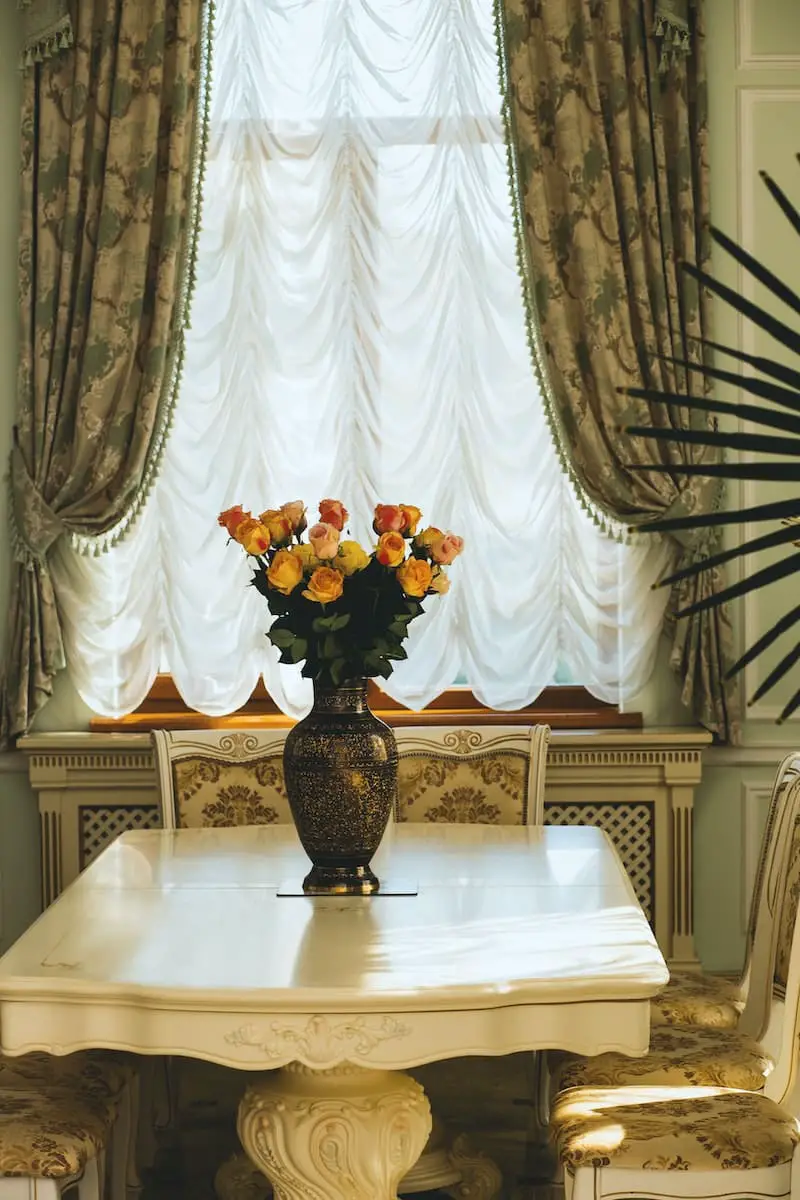Curtains are one of the most versatile and popular types of window treatments that can transform the look and feel of any room. They can provide privacy, light control, insulation, and style to your home. But with so many different styles of curtains available, how do you choose the best one for your home? In this blog post, we will explore the different styles of curtains based on their header, fabric, length, and function, and how to choose the best one for your home.
Curtains are fabric panels that hang from a rod or track above the window and extend to the floor, typically over blinds or shades. They come in different styles based on their header, which determines how they hang and how they look; their fabric, which determines how much light they block and how they feel; their length, which determines how much window they cover and how they affect the room’s proportions; and their function, which determines how much privacy, insulation, noise reduction, and style they provide.
Different Styles Of Curtains Based On Header
The header is the top part of the curtain that attaches to the rod or track. It can have different shapes and forms that create different effects on the curtain’s appearance and function. Here are some of the most common styles of curtains based on their header:
- Rod pocket: This is when the curtain has a pocket at the top that slides over the rod. It creates a casual and relaxed look with soft ruffles at the top. It is easy to install and remove but can be difficult to open and close.
- Grommet: This is when the curtain has metal rings or eyelets at the top that slide over the rod. It creates a modern and sleek look with large and even folds. It is easy to install and remove and easy to open and close.
- Tab top: This is when the curtain has loops or tabs at the top that hang over the rod. It creates a simple and casual look with small and uneven folds. It is easy to install and remove but can be difficult to open and close.
- Pleated: This is when the curtain has pleats at the top that are attached to hooks or rings that hang from the rod or track. It creates a formal and elegant look with structured and uniform folds. It can be difficult to install and remove but easy to open and close. There are different types of pleats, such as pinch pleat, box pleat, goblet pleat, etc., that create different effects on the curtain’s appearance.
- Tie top: This is when the curtain has ties or ribbons at the top that tie around the rod. It creates a romantic and bohemian look with loose and uneven folds. It is easy to install and remove but can be difficult to open and close.

Different Styles Of Curtains Based On Fabric
The fabric is the main part of the curtain that covers the window. It can have different textures, colors, patterns, weights, and transparencies that affect how much light it blocks and how it feels. Here are some of the most common styles of curtains based on their fabric:
- Sheer: This is when the curtain is made from very thin and transparent fabric, such as cotton, linen, gauze, or polyester. It allows most light to pass through while providing some privacy and style. It creates a light and airy look that is ideal for kitchens, bathrooms, or living rooms where more natural light is desired.
- Semi-sheer: This is when the curtain is made from slightly thicker and less transparent fabric than sheer curtains. It allows some light to pass through while providing more privacy and style. It creates a soft and cozy look that is ideal for bedrooms or living rooms where more privacy is desired.
- Room darkening: This is when the curtain is made from medium-weight fabric that blocks out most light while providing privacy and style. It creates a warm and comfortable look that is ideal for bedrooms or living rooms where more light control is desired.
- Blackout: This is when the curtain is made from heavy-weight fabric or has an extra lining that blocks out all light while providing privacy and style. It creates a dark and quiet look that is ideal for bedrooms or media rooms where complete darkness is desired.
Different Styles Of Curtains Based On Length
The length is how long the curtain extends from the rod or track to the floor. It can have different measurements depending on the style and preference. It affects how much window it covers and how it affects the room’s proportions. Here are some of the most common styles of curtains based on their length:
- Sill length: This is when the curtain ends at the windowsill or slightly below it. It covers the window completely while leaving the wall below it exposed. It creates a neat and tidy look that is ideal for small windows or rooms where more wall space is desired.
- Apron length: This is when the curtain ends a few inches below the windowsill or halfway between the windowsill and the floor. It covers the window completely while leaving some wall below it exposed. It creates a balanced and proportionate look that is ideal for medium windows or rooms where more wall space is desired.
- Floor length: This is when the curtain ends at the floor or slightly above it. It covers the window and the wall completely while leaving no gap between the curtain and the floor. It creates a seamless and elegant look that is ideal for large windows or rooms where more window space is desired.
- Puddle length: This is when the curtain extends beyond the floor and puddles on the ground. It covers the window and the wall completely while creating extra fabric on the floor. It creates a dramatic and luxurious look that is ideal for large windows or rooms where more style is desired.

Different Styles Of Curtains Based On Function
The function is what the curtain does for the room besides covering the window. It can provide different benefits depending on the style and preference. Here are some of the most common styles of curtains based on their function:
- Valance: This is a short curtain that covers only the top part of the window. It can be used alone or paired with another curtain to add some color, pattern, texture, or contrast to the window treatment. It can also hide the rod or track and create a more finished look.
- Cafe: This is a short curtain that covers only the lower half of the window. It can be used alone or paired with another curtain to provide some privacy, light control, or style to the window treatment. It can also create a more casual and relaxed look.
- Tier: This is a short curtain that covers only a portion of the window, usually in pairs. It can be used alone or paired with another curtain to provide some privacy, light control, or style to the window treatment. It can also create a more playful and cheerful look.
- Panel pair: This is a long curtain that covers the entire window, usually in pairs. It can be used alone or paired with another curtain to provide more privacy, light control, or style to the window treatment. It can also create a more classic and symmetrical look.
- Single panel: This is a long curtain that covers the entire window, usually in one piece. It can be used alone or paired with another curtain to provide more privacy, light control, or style to the window treatment. It can also create a more modern and asymmetrical look.
How To Choose The Best Style Of Curtain For Your Home
With so many different styles of curtains available, how do you choose the best one for your home? Here are some tips to help you:
- Consider your window size and shape. You want your curtains to fit your window properly and enhance its features. Choose curtains that match or exceed your window measurements and suit your window shape.
- Consider your rod or track type and placement. You want your curtains to hang from your rod or track smoothly and securely. Choose curtains that have compatible hanging methods and suit your rod or track type and placement.
- Consider your room function and mood. You want your curtains to suit your room purpose and mood. Choose curtains that provide the right amount of privacy, light control, insulation, noise reduction, and style for your room.
- Consider your room style and color scheme. You want your curtains to match your room theme and color scheme. Choose curtains that complement or contrast with your existing colors, patterns, textures, and furniture in your room.

FAQs About Different Styles Of Curtains
Here are some common questions that people have about different styles of curtains:
- Can I mix and match different styles of curtains in the same room? Yes, you can mix and match different styles of curtains in the same room if you want to create a more layered and dynamic look for your window treatments. You can pair different headers, fabrics, lengths, and functions to create different effects on your window’s appearance and function.
- Can I use different styles of curtains in different rooms? Yes, you can use different styles of curtains in different rooms depending on your needs and preferences. For example, you can use sheer curtains in your kitchen or bathroom for more light and air; you can use blackout curtains in your bedroom or media room for more darkness and quietness; you can use pleated curtains in your living room or dining room for more elegance and sophistication; etc.
Thats It!
Hopefully this guide has been super helpful in picking the best curtains for your abode. Weather you want some fancy pleated curtains or some minimalistic curtains – theres an option for every Huetiful Home!
Dale is the colorful mind behind HuetifulHomes.com, where he shows you how to create a home that is as fun and fabulous as you are. He has a passion for color and a knack for DIY, with years of interior design experience he shares his tips and tricks on how to create a home that reflects your personality and style. He believes that color is the key to happiness, and he wants to help you make your home more Huetiful.



